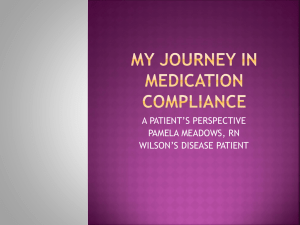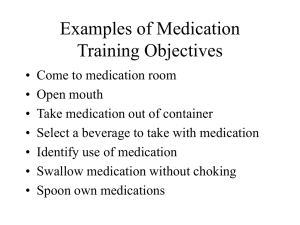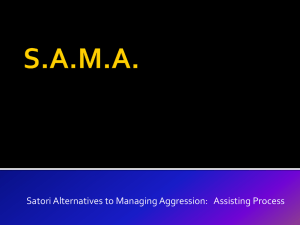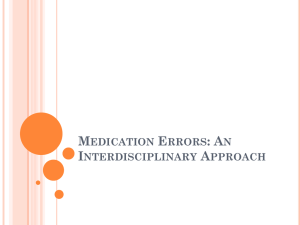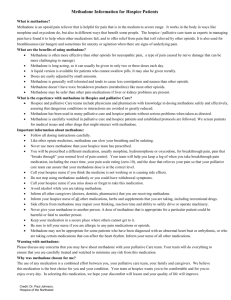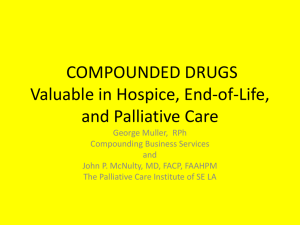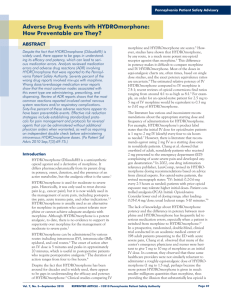Clysis Pain and Symptom Management
advertisement
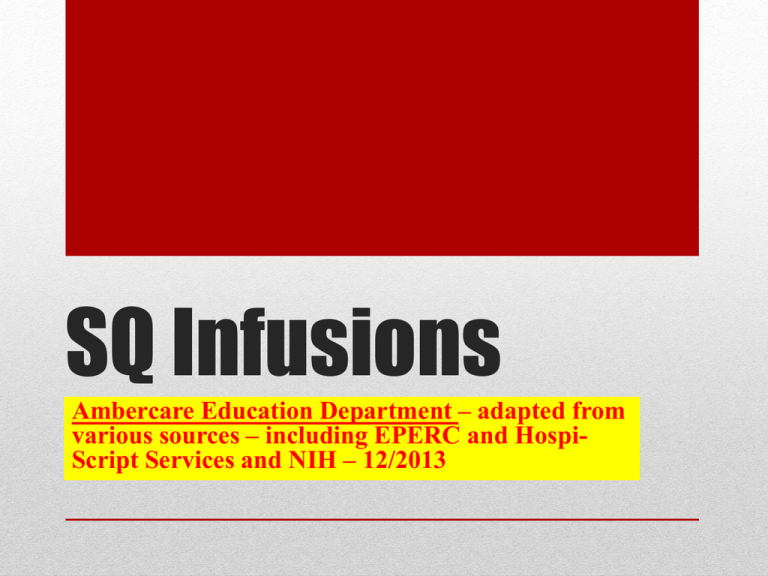
SQ Infusions Ambercare Education Department – adapted from various sources – including EPERC and HospiScript Services and NIH – 12/2013 • • • • • • • Explain the Subcutaneous Butterfly Procedure Indications of use Procedure for insertion S/sx of infection; cannula misplacement, or overuse of site Process for administering more than one medication Amount of medication to be administered at one time Medications that can be given via the SQ route (butterfly) – and medications not recommended via this route • Sites of administration • Hydration therapy • Advantages / Disadvantages OBJECTIVES • Sublingual • Administration of concentrate solution (Morphine, Methadone, or Oxycodone) • Immediate Release Tablets (Methadone, Morphine, Oxycodone, and Hydromorphone) may be crushed and given with a very small amount of liquid • Rectal • Insertion of IR and ER tablets with a water based lubricant (morphine, Oxycodone, Hydromorphone and Methadone) • Subcutaneous • Individual site injection or butterfly placement (Morphine, Hydromorphone, Methadone) Options for Pain Management Modalities • Intravenous • Generally seen in an GIP setting with PICC line or port access (PCA may also be utilized in this setting) • IV push • Transdermal • Application of fentanyl patch Options for Pain Management Continued • SL: • SL space can comfortably hold an approximate maximum volume of 1.5 ml per dose (patient dependent) • PR: • May be restricted by blockage of rectal vault due to disease process • SC: • Volumes > 2 ml are not recommended to be INJECTED at one site (excluding flush) • IV: • Patent vein access • TD: • Should only be utilized in patients with STABLE pain. Patches are easily titrated and CANNOT provide QUICK onset of drug action in a pain crisis! Limitations with all routes of administration • The butterfly, wing-tip, or scalp needle is useful for providing medications via the subcutaneous (SQ) route. The SQ route of medication administration provides appropriate management of symptoms for patients who are unable to take medications through other routes of administration SQ butterfly procedure DEFINTION • Circumstances that preclude or compromise oral administration • Dysphagia – due to neuromuscular weakness or mechanical obstruction • Decrease LOC • Intestinal obstruction • Nausea and vomiting (intractable) • Symptom control crisis requiring rapid and reliable medication administration and absorption INDICATIONS • Poor or variable compliance issues: • Dementia • Agitated delirium, with paranoia and non-compliance • Personality issues INDICATIONS - CONTINUED • Alcohol swabs • Butterfly or wing-tipped catheter, 25 - 27 gauge (generally) • Transparent adhesive dressing • Luer-lock injection cap • Tape • Gloves • Sharps Container Procedure for Inserting SQ Butterfly – Equipment needed • • • • • • Leaking Redness Exudates Localized heat Localized inflammation Pain, Tenderness, Hardness, Burning, Swelling, Scarring, Itching, Bruising, unresolved blanching, or necrosis Monitoring for adverse s/sx at SQ site • Establish an additional SQ site for each new medication or if there is a change in the concentration of the current medication. Label each site as to which medication is to be administered at that site Administering more than one medication • Equipment Needed: • 3cc Syringe • Alcohol swabs • Medication • Gloves Instilling Medications through SQ Butterfly (Intermittent push) • Equipment Needed: • Alcohol Swabs • Medication in appropriate IV bag or Syringe (based on pump used) • Continuous Infusion Pump (Curlin PCA pump) • 3 cc syringe with 1 cc of normal saline • Tubing Initiating a Continuous SQ Infusion (basal rate) • • • • • • • • • • • 0.9% or 0.45% (NS or ½ NS) 2.5% or 5% Dextrose (D5W) Dexamethasone (steroid) Diphenhydramine (benadryl) Fentanyl (opioid) Furosemide (loop diuretic) Glycopyrrolate (robinul – AC) Haloperidol (haldol) Heparin (anticoagulant) Hydromorphone (Dilaudid) Sufentanil (sufenta – general) • • • • • • • • • • Ketamine (anesthetic) Lorazepam (benzo - ativan) Metoclopramide (reglan) Methadone (pain) Midazolam (versed) Morphine (opioid agonist) Naloxone (narcan - antag) Octreotide (sandostatin) Phenobarbital (seizures) Ranitidine (zantac) Meds given SQ route via SQ Butterfly • • • • • Chlorpromazine (anti-psychotic) Diazepam (benzodiazepine) Hydroxyzine (atarax) Hypertonic solutions (3% Na+Cl) Prochlorperazine (compazine) Meds NOT recommended for SQ route per SQ Butterfly • Outer arm (not recommended for hypodermoclysis)! • Abdomen (avoid in presence of tense abdominal distention such as ascites) • Thigh • Subclavicular area (avoid when patient has lung disease or is active (r/f pneumothorax) • Upper back (use when other sites are unsuitable and/or when patient is confused) Possible SQ insertion Sites • • • • • • • • Areas with lymphedema or edema Areas that have TOO LITTLE SQ tissue Areas with broken skin Skin sites that have recently been irradiated Sites with infection or inflammation present Areas of bony prominences Tumor sites Skin folds SQ Insertion sites to be avoided • www.youtube.com/watch?v=c0BGbB82Fyc Questions/Comments?



